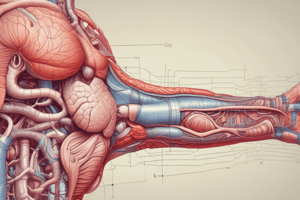Podcast
Questions and Answers
What is the primary function of the esophagus in the digestive process?
What is the primary function of the esophagus in the digestive process?
- To transport food to the stomach through peristalsis (correct)
- To break down food into smaller pieces
- To absorb nutrients into the bloodstream
- To produce digestive enzymes for protein breakdown
What is the main function of the villi in the small intestine?
What is the main function of the villi in the small intestine?
- To produce digestive enzymes for carbohydrate breakdown
- To absorb water and electrolytes from the diet
- To increase the surface area for nutrient absorption (correct)
- To regulate the pH balance in the gut
What is the primary function of the large intestine?
What is the primary function of the large intestine?
- To regulate water and electrolyte balance in the body (correct)
- To produce digestive enzymes for protein breakdown
- To store bile salts for fat emulsification
- To absorb nutrients into the bloodstream
What is the exocrine function of the pancreas?
What is the exocrine function of the pancreas?
What is the function of the mucosa layer in the stomach?
What is the function of the mucosa layer in the stomach?
What is the function of the liver in the digestive process?
What is the function of the liver in the digestive process?
Flashcards are hidden until you start studying
Study Notes
Mouth and Esophagus
- Mouth:
- Mechanical digestion: teeth chew food into smaller pieces
- Chemical digestion: salivary enzymes (amylase, lipase) break down carbohydrates and fats
- Mixing of food with saliva forms a bolus
- Esophagus:
- Muscular tube that uses peristalsis to transport bolus to stomach
- Food passage takes around 7-10 seconds
Small Intestine Function
- Primary site of nutrient absorption:
- Walls lined with finger-like projections (villi) for increased surface area
- Nutrients absorbed into bloodstream and transported to liver for processing
- Enzymes and digestive processes:
- Pancreatic juices and bile salts break down carbohydrates, proteins, and fats
- Lactase, sucrase, and maltase break down lactose, sucrose, and maltose
Large Intestine Process
- Water absorption and electrolyte regulation:
- Water reabsorption from indigestible material
- Electrolyte regulation for maintaining hydration and pH balance
- Feces formation:
- Remaining waste material forms feces
- Feces stored in rectum until elimination through anus
Liver and Pancreas Roles
- Liver:
- Detoxification: removes toxins from bloodstream
- Metabolism regulation: regulates glucose, fat, and protein metabolism
- Production of bile salts for fat emulsification
- Pancreas:
- Exocrine function: produces digestive enzymes for small intestine
- Endocrine function: produces hormones (insulin, glucagon) for glucose regulation
Stomach Anatomy
- Layers:
- Mucosa: innermost layer with rugae (folds) for increased surface area
- Submucosa: connective tissue layer
- Muscularis: smooth muscle layer for mixing and churning
- Gastric glands:
- Produce gastric juices containing pepsin and hydrochloric acid
- Pepsin breaks down proteins into peptides and amino acids
Studying That Suits You
Use AI to generate personalized quizzes and flashcards to suit your learning preferences.




